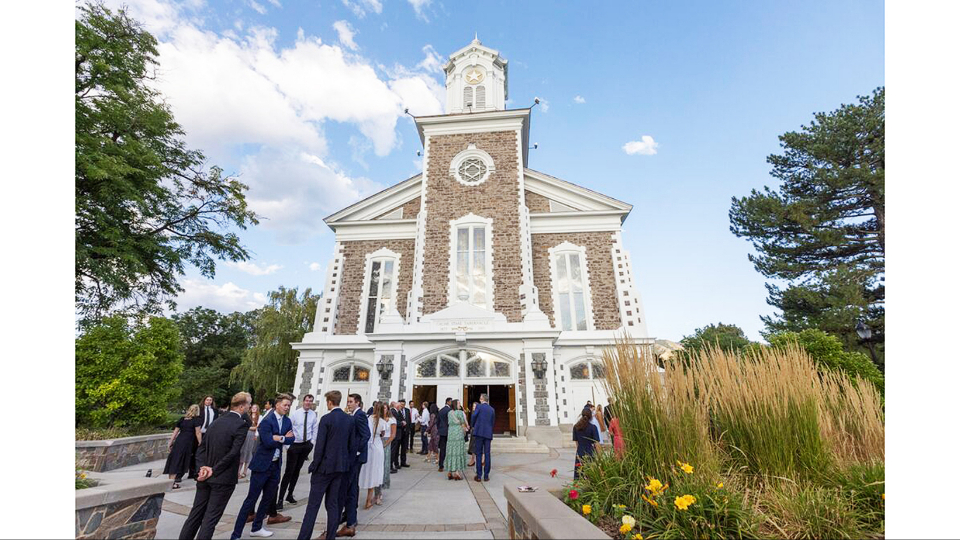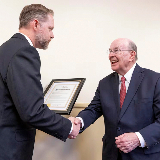| The Logan Tabernacle after its rededication in Logan, Utah, on Sunday, August 25, 2024. Photo by Brice Tucker, courtesy of Church News. Copyright 2023 Deseret News Publishing Company. | 1 / 9 |
This story appears here courtesy of TheChurchNews.com. It is not for use by other media.
By Ryan Jensen, Church News
On a pristine August evening in Utah’s Cache Valley, Elder Quentin L. Cook of the Quorum of the Twelve Apostles stepped to the pulpit of a building he has known since he was a child.
“I remember listening to the leaders of the Church speaking in this tabernacle at stake conferences,” Elder Cook said, as he spoke to a capacity crowd of nearly 1,000 individuals. “I loved hearing from these leaders when I was a little older. Most of them inspired in me a desire to live a more Christlike life.”
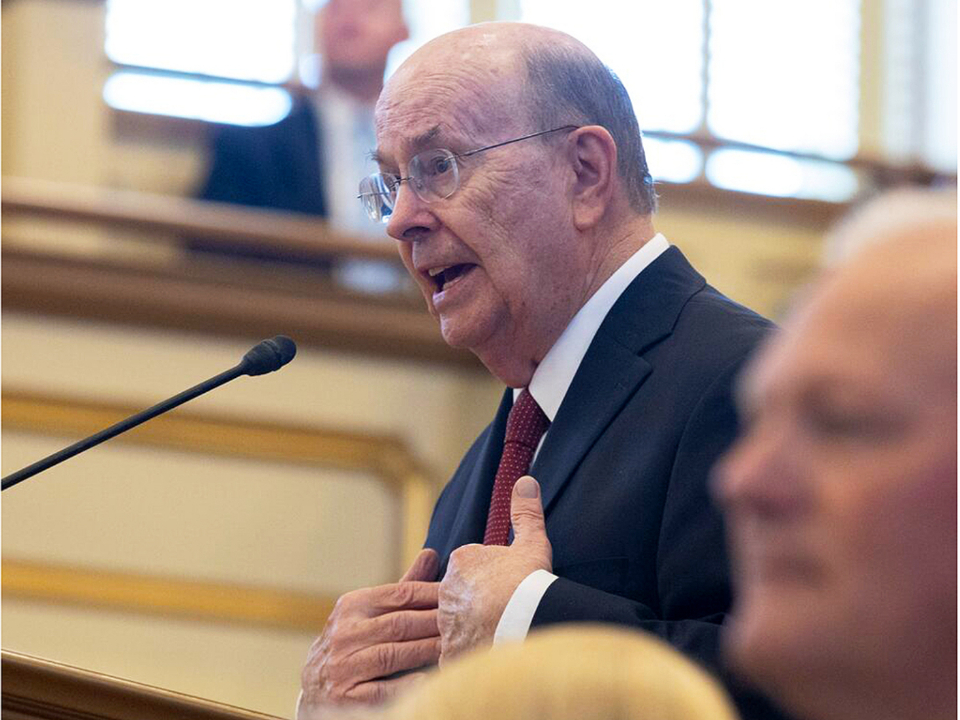
Cook-Logan-Tabernacle-dedication
Elder Quentin L. Cook of the Quorum of the Twelve Apostles speaks during the Logan Tabernacle’s rededication in Logan on Sunday, August 25, 2024. Photo by Brice Tucker, courtesy of Church News.Copyright 2023 Deseret News Publishing Company.The tabernacle was filled on Sunday, August 25, with many who had historic ties to the valley, as well as civic leaders and representatives from nearby Utah State University. Among them, the university’s recently inaugurated President Elizabeth Cantwell attended the meeting.
Elder Cook was joined by his wife, Mary, who also grew up in Logan. New Sunday School General President Paul V. Johnson attended with his wife, Jill. Elder Thomas K. Checketts, an Area Seventy, conducted the meeting and was joined by his wife, Lynette. Elder Checketts also grew up in the area and shared some of his own memories of Church meetings held in the historic tabernacle.
President Johnson, who was sealed to Sister Johnson in the nearby Logan Utah Temple, shared the stories of various pioneer builders of both the tabernacle and the Church.
“Could those who gave so much possibly see the ramifications of their sacrifices generations later?” he asked. “… Like them, we also are in the construction business. … We are helping those around us build their lives.”
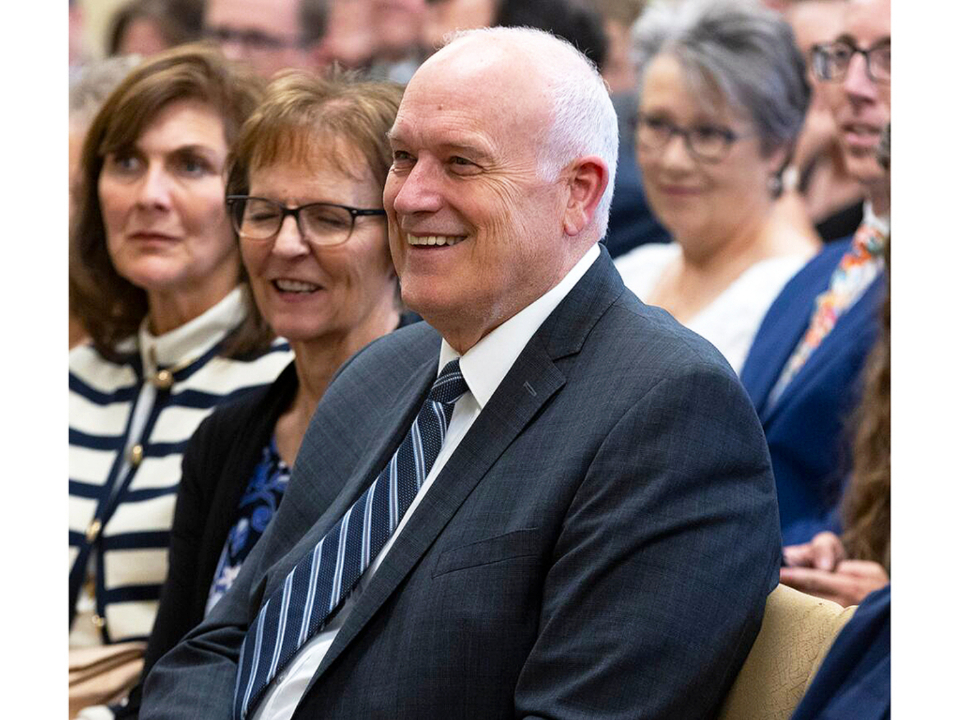
Cook-Logan-Tabernacle-dedication
Sunday School General President Paul V. Johnson smiles during the Logan Tabernacle’s rededication in Logan on Sunday, August 25, 2024. Photo by Brice Tucker, courtesy of Church News.Copyright 2023 Deseret News Publishing Company.Elder Checketts recalled how those who labored to build the tabernacle were called away by then Church President Brigham Young after he visited Cache Valley in 1877 and chose the site for the Logan Utah Temple. With the outside of the tabernacle nearly complete, many workers shifted their efforts a few blocks north and east to help build a house of the Lord.
“This was a good lesson for me that sometimes important projects must be left in order for temple work to be done,” Elder Checketts said.
Sister Kimberli Eyre Burbank grew up in Logan and was also invited to share her testimony and feelings about the tabernacle. She shared the story of a son who accidentally bit into a piece of candy that had peanuts as an ingredient. His allergic reaction to the peanuts restricted his airway. Burbank instinctively grabbed the EpiPen her son required and drove immediately to the hospital.
Upon arrival, the doctors treated her son quickly and helped him recover. One doctor pointed out to Burbank that the medicine in the pen applicator she had grabbed would have helped more if she had used it on her son. She had merely kept it in her hand.
“Scriptures are the same for us,” she said. “Their words do us no good if we don’t use them.”
Elder Cook spoke of building on the heritage of those who have gone before and sacrificed to bless future generations of people they would not meet in this life.
“The German philosopher Goethe said, ‘What from your father’s heritage is lent, earn it anew to really possess it.’ One of our purposes today is to renew the heritage of the Logan Tabernacle,” he said.
That personal heritage for Elder Cook in the tabernacle includes celebrating Easter, attending many stake conferences, commemorating his seminary graduation and bearing his testimony after returning from the British Mission in 1962.
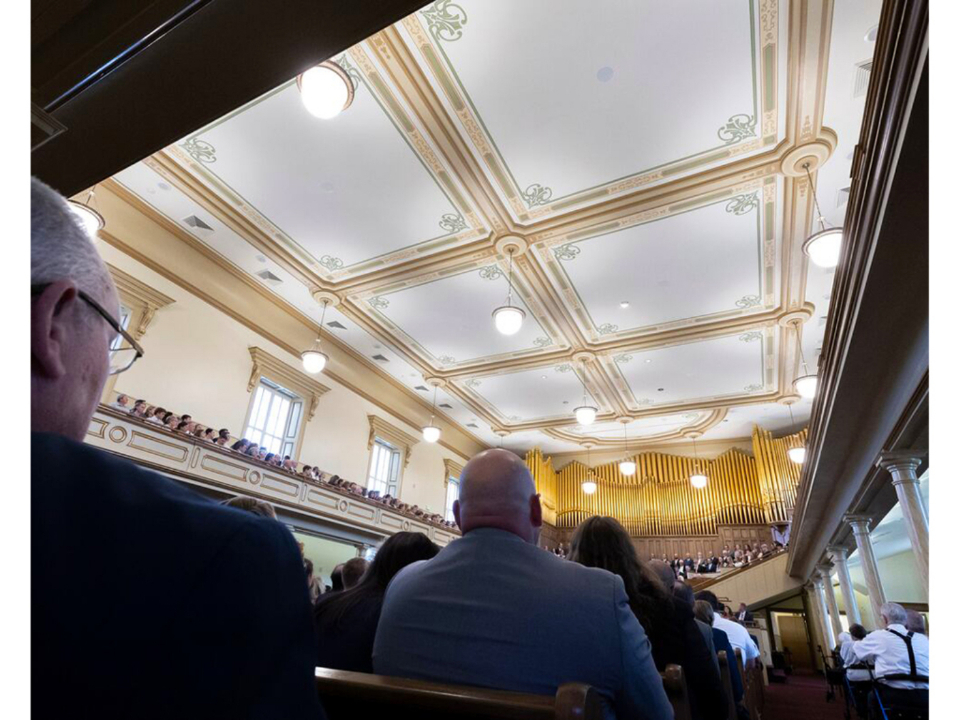
Cook-Logan-Tabernacle-dedication
The renovated ceiling frescos can be seen during the Logan Tabernacle’s rededication in Logan on Sunday, August 25, 2024. Photo by Brice Tucker, courtesy of Church News.Copyright 2023 Deseret News Publishing Company.He also noted that the building has long been open to serve the needs of the greater community and was not used exclusively for Church meetings. This included a visit from Theodore Roosevelt, who spoke in the tabernacle in 1900, the year before he began his service as president of the United States.
Elder Cook noted that, “Community concerts have been particularly effective. For many years, a sing-along event of the ‘Messiah’ was deeply appreciated. Christmas concerts have been special in recent years.” Other events and concerts are held regularly in the building on Logan’s Main Street.
“Even though the early pioneers were members of The Church of Jesus Christ of Latter-day Saints, from the beginning our faith was determined to protect religious freedom for people of diverse faith as well as those of no faith,” Elder Cook said. “In this valley our faith — working with Catholics, Evangelicals, Jews, Muslins and other faiths — have striven to succor, be a sanctuary and respect people regardless of faith or no faith.”
In the rededicatory prayer, Elder Cook recognized the sacrifices of those who emigrated from the British Isles, Scandinavia, Germany, Switzerland and other European countries.
“Whatever our faith and however long we may or may not have lived in Cache Valley, we are the beneficiaries of those who came and stayed, who settled and struggled, building civilization out of the wilderness and helped it ‘blossom as the rose,’” he said.
History and Renovations of the Logan Tabernacle
Construction began on the tabernacle in 1865 and was completed in 1891. Four years before it was finished, meetings and classes were first held in the building’s basement in 1887. The original pipe organ was installed in 1908. And the building was added to the National Register of Historic Places in 1975.
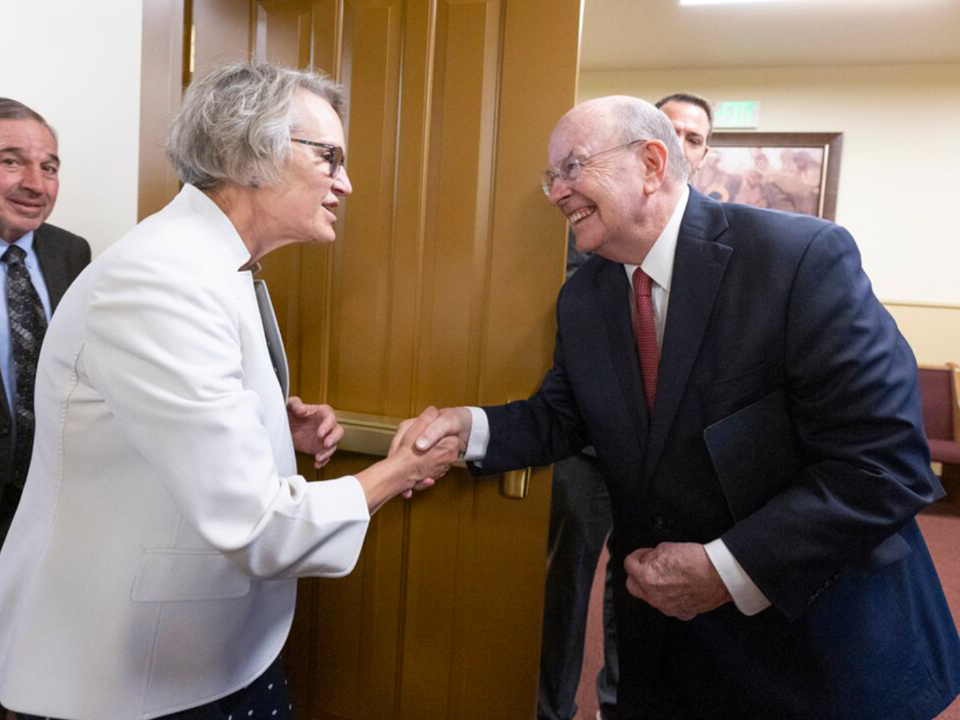
Cook-Logan-Tabernacle-dedication
President of Utah State University Elizabeth R. Cantwell shakes hands with Elder Quentin L. Cook of the Quorum of the Twelve Apostles during the Logan Tabernacle’s rededication in Logan on Sunday, August 25, 2024. Photo by Brice Tucker, courtesy of Church News. Copyright 2023 Deseret News Publishing Company.Elder Cook noted prior to the rededication meeting that the Logan Tabernacle, similar to the original Salt Lake Tabernacle, was built with a baptismal font in it. Many Latter-day Saints from Logan were baptized in that font over 100 years. But, also like the Salt Lake Tabernacle following its renovations, the Logan Tabernacle no longer has a baptismal font in it.
Matt Painter, general contractor of the renovation project, said many prayers were offered during the 30-month project to seek heaven’s help in restoring what so many pioneers worked tirelessly to complete.
“And I gained an appreciation for what they did because this building was in magnificent shape,” he said.
The Church’s historic sites curator, Emily Utt, said she feels that those late-night prayers and the efforts of the construction teams to work together were a reflection of the pioneer laborers whose first meeting in the original tabernacle was a call for unity in the community.
“The prayers, devotion, dedication and unity of the team today, I hope, is a reflection of the unity of those Saints,” she said. “We fought as hard for this building as they fought for this building.”
James Dzineku, the renovation’s project manager, said that unity came as unexpected challenges arose during the renovation process.
“We had to find ways and solutions around the complications and complexities on this project,” he said.
Dzineku said the team’s prayers were answered in ways that helped them accomplish what they needed to.
Among the challenges the construction team faced during the renovations was Logan having one of its harshest winters in 40 years, Painter said. The temperatures were so cold that some of the machines froze and broke. He said that challenge made him even more grateful and inspired as he considered the obstacles faced by the pioneers who didn’t have any such machines while building the tabernacle.
One of the changes that had to be made for structural reasons was the removal of some of the center seating in the tabernacle’s balcony. However, Utt pointed out that the new wall that occupies that space provided a wonderful space on which to place an Everett Thorpe painting that had originally been placed above the entry to the tabernacle. As the renovations moved forward, another Thorpe paining was discovered that had been covered up at some point in the tabernacle’s history. That painting was restored and now hangs in a new gathering space beneath the tabernacle’s main hall.
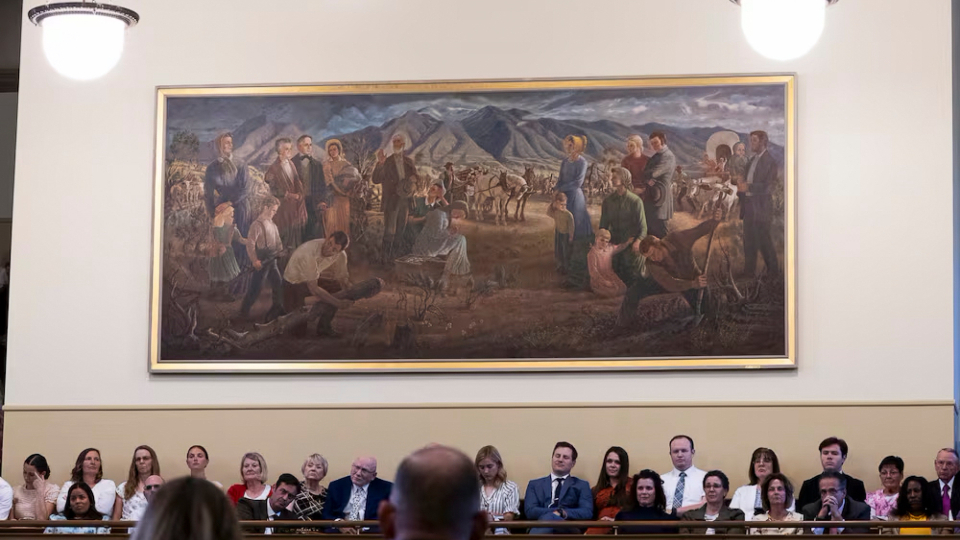
Cook-Logan-Tabernacle-dedication
A new painting sits over the back balcony section of the tabernacle during the Logan Tabernacle’s rededication in Logan on Sunday, August 25, 2024. Photo by Brice Tucker, courtesy of Church News.Copyright 2023 Deseret News Publishing Company.Copyright 2023 Deseret News Publishing Company.
